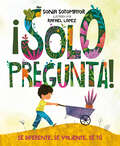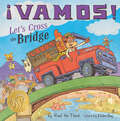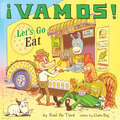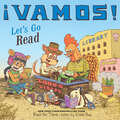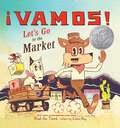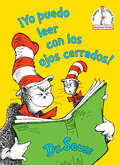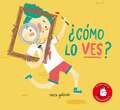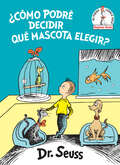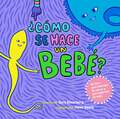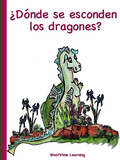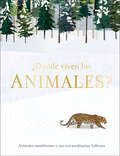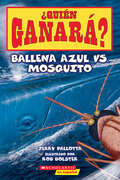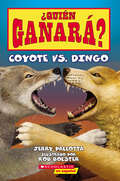- Table View
- List View
¡Solo pregunta!: Sé Diferente, Sé Valiente, Sé Tú
by Sonia SotomayorSonia y sus amigos siembran un jardín, y cada uno contribuye a su manera. Rafael tiene asma y a veces debe mantener la calma para poder respirar mejor, lo que le permite pintar bellas rocas para el jardín. Anthony utiliza una silla de ruedas para moverse rápidamente y dirigir al grupo. Anh tartamudea al hablar y prefiere escuchar. Por eso sabe cómo sembrar cada flor. Todos los amigos son diferentes, pero todos tienen algo en común: ¡les gusta hacer preguntas y saber más acerca de sus compañeros!En esta tierna historia que refleja la diversidad, escrita por Sonia Sotomayor, juez del Tribunal Supremo de Estados Unidos, e inspirada en su propia experiencia tras diagnosticarle diabetes durante su infancia, los lectores descubrirán cómo los niños de esta historia utilizan sus habilidades y fortalezas para trabajar juntos y aprender los unos de los otros. Con vibrantes y llamativas ilustraciones del galardonado artista Rafael López, este libro nos demuestra que las diferencias son maravillosas, y que si en alguna ocasión no entiendes algo, no debes quedarte callado, ¡SOLO PREGUNTA!
¡Tamales! (¡Arriba la Lectura!, Leveled Reader Benchmark K-2, Level G #7)
by Burgundy Beam Dixie PetrokisNIMAC-sourced textbook
¡Tocamos!: Mexican Folk Art Music Makers in English and Spanish (First Concepts in Mexican Folk Art #8)
by Cynthia WeillYoung readers will delight in learning about a wide variety of musical instruments in English and Spanish through beautifully handcrafted sculptures from Oaxaca, Mexico. Los lectores jóvenes se deleitarán aprendiendo sobre una amplia variedad de instrumentos musicales en inglés y español a través de bellas esculturas hechas a mano en Oaxaca, México.Musical feathered friends gather to form an ensemble! A rooster brings a double bass, a crow totes a trombone, and a macaw carries an accordion. They are almost all together but wait--someone is missing! Once the final member joins the group, the music begins! Featuring vibrant wood carvings and rhythmic text that's fun to read aloud in both English and Spanish, ¡Tocamos! introduces children to many orchestral instruments played at concerts in Mexican town squares. Each bird was lovingly hand carved and painted by master woodcarver Avelino Pérez who lives in Oaxaca, Mexico. Both Cynthia and Avelino are delighted to teach children the names of instrumentos musicales in Spanish and English. ¡Amigos musicales emplumados se reúnen para formar un conjunto! Un gallo trae un contrabajo, un cuervo lleva un trombón y una guacamaya lleva un acordeón. Están casi todos juntos pero espera, falta alguien. Una vez que el último miembro se une al grupo, ¡comienza la música! Con vibrantes tallas de madera y texto rítmico que es divertido leer en voz alta tanto en inglés como en español, ¡Tocamos! presenta a los niños muchos instrumentos orquestales que se tocan en conciertos en las plazas de las ciudades mexicanas. Cada pájaro fue cuidadosamente tallado y pintado a mano por el maestro tallador de madera Avelino Pérez, que vive en Oaxaca, México. Tanto Cynthia como Avelino están encantados de enseñar a los niños los nombres de instrumentos musicales en español e inglés.
¡Vamos! Let's Cross the Bridge (World of ¡Vamos!)
by Raúl the Third IIIWinner of the Pura Belpré Medal! A New York Times Best Illustrated Children's Book!Little Lobo and Bernabé return in ¡Vamos! Let’s Cross the Bridge, a joyful picture book follow-up to ¡Vamos! Let’s Go Eat about coming together and celebrating community from New York Times bestselling, three-time Pura Belpré Award–winning author-illustrator Raúl the Third.People are always crossing the bridge for work, to visit family, or for play. Some going this way; others going that way. Back and forth they go. With friends on foot and in bicycles, in cars and trucks, the bridge is an incredibly busy place with many different types of vehicles.Little Lobo and his dog Bernabé have a new truck and they are using it to carry party supplies over the bridge with their pals El Toro and La Oink Oink. The line is long and everyone on the bridge is stuck. How will they pass the time?
¡Vamos! Let's Go Eat (World of ¡Vamos!)
by Raúl the Third IIIWinner of the Pura Belpré Medal!Little Lobo returns to share his love of food and wrestling in ¡Vamos! Let’s Go Eat, a picture book follow-up to ¡Vamos! Let’s Go to the Market from New York Times bestselling, three-time Pura Belpré Award–winning author-illustrator Raúl the Third.Little Lobo is excited to take in a show with wrestling star El Toro in his bustling border town!After getting lunch orders from the luchador and his friends to help prepare for the event, Little Lobo takes readers on a tour of food trucks that sell his favorite foods, like quesadillas with red peppers and Mexican-Korean tacos.Peppered with easy-to-remember Spanish vocabulary and packed with fun details and things to see, this glorious celebration of food is sure to leave every reader hungry for lunch!
¡Vamos! Let's Go Read (World of ¡Vamos!)
by Raúl the Third IIIFrom New York Times bestselling, Pura Belpré Award–winning author-illustrator Raúl the Third, ¡Vamos! Let's Go Read follows Little Lobo and friends as they explore their library's Libro Love Book Festival in this picture book from the World of ¡Vamos!Little Lobo and his friends are excited for the out-of-this-world book festival the Guadalupian Library hosts every year!Everyone has a special book they're looking for, but there's so much to see and do first. From cookbook demonstrations and comics workshops to mask making and language classes, this library has something for everyone. Can Little Lobo, Bernabé, Kooky Dooky, Coco Rocho, and La Chida each find the book of their dreams?Full of easy-to-remember Spanish vocabulary and packed with fun details, this colorful celebration of books, libraries, and all forms of reading will bring joy to young bookworms everywhere!
¡Vamos! Let's Go to the Market (World of ¡Vamos!)
by Raúl the Third IIIAn Eisner Award Nominee! A Pura Belpré Award Honor Book!Explore the marketplace of a buzzing Mexican-American border town in ¡Vamos! Let’s Go to the Market, a picture book from New York Times bestselling, three-time Pura Belpré Award–winning author-illustrator Raúl the Third.Bilingual in a new way, this colorful adventure teaches readers simple words in Spanish as they experience the bustling life of a border town. Follow Little Lobo and his dog Bernabe as they deliver supplies to a variety of vendors, selling everything from sweets to sombreros, portraits to piñatas, carved masks to comic books!
¡Veo las tortugas! (¡Arriba la Lectura!, Leveled Reader Benchmark K-2, Level A #1)
by Bradley Clark Cynthia Clark Lesley FieldsNIMAC-sourced textbook
¡Ya podemos seguir! (¡Arriba la Lectura!, Leveled Reader Benchmark K-2, Level E #5)
by Lisa Trumbauer Mike DammerNIMAC-sourced textbook
¡Yo puedo leer con los ojos cerrados! (Beginner Books(R))
by Dr. SeussEdición en español y rimada del clásico de la colección Beginner Books de Dr. Seuss ¡con su protagonista estrella El Gato Ensombrerado! El Gato Ensombrerado nos enseña que, aun sin ver las palabras, ¡leer es divertido! «Y mientras más leas, más cosas aprenderás. Y cuanto más tú aprendas, más lejos vas a llegar!». Ya sea en la cama, en morado o en marrón, ¡leer es divertido aunque sea al revés! ¡Yo puedo leer con los ojos cerrados! es ideal para fomentar el amor por la lectura… ¡Y POR Dr. Seuss! Creada por Dr. Seuss, los libros para primeros lectores de la colección Beginner Books estimulan a los niños a leer ellos solos con palabras sencillas y divertidos dibujos que dan sentido a la lectura.Las ediciones rimadas, en español, de los clásicos de Dr. Seuss, publicadas por Random House, brindan la maravillosa oportunidad de disfrutar de sus historias a más de treinta y ocho millones de personas hispanohablantes en Estados Unidos. Los lectores podrán divertirse con las ediciones en español de The Cat in the Hat (El Gato Ensombrerado); Green Eggs and Ham (Huevos verdes con jamón); One Fish Two Fish Red Fish Blue Fish (Un pez, dos peces, pez rojo, pez azul); The Lorax (El Lórax); Oh, the Places You'll Go! (¡Oh, cuán lejos llegarás!); How the Grinch Stole Christmas! (¡Cómo el Grinch robó la Navidad!); The Cat in the Hat Comes Back (El Gato Ensombrerado ha regresado); I Can Read With My Eyes Shut! (¡Yo puedo leer con los ojos cerrados!); Horton Hears a Who! (¡Horton escucha a Quién!); The 500 Hats of Bartholomew Cubbins (Los 500 sombreros de Bartolomé Cubbins); There's A Wocket in my Pocket! (¡Hay un Molillo en mi Bolsillo!); Mr. Brown Can Moo! Can You? (¡El Sr. Brown hace Muuu! ¿Podrías hacerlo tú?); Ten Apples on Top! (¡Diez manzanas en la cabeza!); What Pet Should I Get? (¿Cómo podré decidir qué mascota elegir?); y Yertle the Turtle and Other Stories (Yoruga la Tortuga y otros cuentos). A rhymed Spanish edition of the classic Beginner Book by Dr. Seuss—starring the Cat in the Hat!The Cat in the Hat shows that reading is fun—even when you don't look at the words! "The more that you read, the more things you will know. The more that you learn, the more places you'll go." Whether reading in bed or in purple or brown, reading is fun--even upside down! I Can Read with My Eyes Shut! is a perfect choice for beginning readers that will nurture their love of reading...AND of Dr. Seuss!Originally created by Dr. Seuss, Beginner Books encourage children to read all by themselves, with simple words and illustrations that give clues to their meaning.Random House's rhymed, Spanish-language editions of classic Dr. Seuss books make the joyful experience of reading Dr. Seuss books available for the more than 38 million people in the United States who speak Spanish. Readers can enjoy The Cat in the Hat (El Gato Ensombrerado); Green Eggs and Ham (Huevos verdes con jamón); One Fish Two Fish Red Fish Blue Fish (Un pez, dos peces, pez rojo, pez azul); The Lorax (El Lórax); Oh, the Places You'll Go! (¡Oh, cuán lejos llegarás!); How the Grinch Stole Christmas! (¡Cómo el Grinch robó la Navidad!); The Cat in the Hat Comes Back (El Gato Ensombrerado ha regresado); I Can Read With My Eyes Shut! (¡Yo puedo leer con los ojos cerrados!); Horton Hears a Who! (¡Horton escucha a Quién!); The 500 Hats of Bartholomew Cubbins (Los 500 sombreros de Bartolomé Cubbins); There's A Wocket in my Pocket! (¡Hay un Molillo en mi Bolsillo!); Mr. Brown Can Moo! Can You? (¡El Sr. Brown hace Muuu! ¿Podrí
¡ZUM! La historia del snowboard (¡Arriba la Lectura!, Level M #72)
by Lisa TrumbauerSi te gusta la nieve, tal vez te guste practicar snowboard. ¡Lee sobre este divertido deporte! NIMAC-sourced textbook
¿Cómo lo ves?
by Vera GalindoThe other day I discovered something amazing! We don't all see everything the same. A journey through art led by grand contemporary artists: Picasso, Barquiat, Frida Khalo, Mondrian, etc. Discover how they paint the things they see and that inspire them. And the best part, see how you can paint them, too.
¿Cómo podré decidir qué mascota elegir? (Beginner Books)
by Dr. SeussEdición en español y rimada del libro para primeros lectores de Dr. Seuss acerca de elegir una mascota ¡y lo difícil que es tomar una decisión! ¿Qué sucede cuando dos hermanos van a una tienda para comprar una mascota? Como es de esperar, ¡no saben por cuál decidirse! Con la participación de los mismos niños del cuento Un pez dos peces pez rojo pez azul, este libro para primeros lectores capta el típico momento en la vida de un niño en el que ha de elegir una mascota, a la vez que nos enseña una lección de vida: es difícil decidirte, ¡pero a veces tienes que hacerlo! Un magnífico regalo para los pequeños amantes de los animales y admiradores de Dr. Seuss, y a la vez ideal para leer en voz alta o para los niños que comienzan a leer ellos solos. Descubierto veintidós años después de la muerte de Dr. Seuss, el manuscrito original y los bocetos fueron anteriormente publicados en una edición de 48 páginas con sobrecubierta y 8 páginas con comentarios y datos. Esta nueva edición de Beginner Books, sin solapas, solo incluye la historia.Las ediciones rimadas, en español, de los clásicos de Dr. Seuss, publicadas por Random House, brindan la maravillosa oportunidad de disfrutar de sus historias a más de treinta y ocho millones de personas hispanohablantes en Estados Unidos. A rhymed Spanish edition of Dr. Seuss's Beginner Book about chosing a pet—and the difficulty of making decisions!What happens when a brother an sister visit a pet store to pick a pet? Naturally, they can't pick just one! Featuring the kids from One Fish Two Fish Red Fish Blue Fish, this beginning reader takes a classic childhood moment—choosing a pet—and uses it to illuminate a life lesson: that it's hard to make up your mind, but sometimes you just have to do it! A great gift for young Dr. Seuss fans and animal lovers, it's perfect for reading aloud or children learning to read by themselves. Discovered 22 years after Dr. Seuss's death, the unpublished manuscript and sketches for What Pet Should I Get?were previously published as a 48-page jacketed hardcover with 8 pages of commentary. This unjacketed Beginner Book edition features the story only.Random House's rhymed, Spanish-language editions of classic Dr. Seuss books make the joyful experience of reading Dr. Seuss books available for the more than 38 million people in the United States who speak Spanish.
¿Cómo se ayudan los seres vivos? (¡Arriba la Lectura!, Level I #6)
by Alice ReardonLas plantas, los animales y las personas se ayudan unos a otros. ¿Cómo ayudas tú? NIMAC-sourced textbook
¿Cómo se hace un bebé?: Spanish Language Edition
by Cory SilverbergÁlbum ilustrado en el que se explica a los niños de dónde vienen los niños y como son concebidos. ¿De dónde vienen los bebés?¿De dónde vengo yo?Dos preguntas que se hacen todos los niños en un momento determinado, sobre todo cuando está a punto de llegar un nuevo miembro a la familia.Escrito e ilustrado para incluir todo tipo de bebés, adultos y familias, este libro enseña qué es la concepción, la gestación y el nacimiento.Los padres encontrarán el espacio idóneo para educar a sus hijos sin tener que eludir su propia experiencia.
¿De dónde viene la comida? (Text Connections Guided Close Reading)
by Jeffrey B. FuerstNIMAC-sourced textbook
¿De verdad es sabio el búho? (¡Arriba la Lectura!, Level I #3)
by Shoo RaynerTodos los animales le piden consejos al búho sabio. ¿Por qué creen que es sabio? NIMAC-sourced textbook
¿Dónde está Brinca? (¡Arriba la Lectura!, Level K #36)
by Misha Herenger Jeff HopkinsBrinca es una rana arbórea. Descubre qué aprenden los niños de su nueva compañera de clase. NIMAC-sourced textbook
¿Dónde se esconden los dragones?
by Rkh Bowman Joan Casler Heather Stannard Camille LocksteinDescubre las aventuras de Robert en su busqueda por los elusivos dragones, de los cuales ha escuchado cada noche cuando su padre le lee antes de irse a dormir. Niños desde los 4 años disfrutaran este encantador cuento imaginativo.
¿Dónde va a parar?
by Julia AlvarezEl nuevo libro ilustrado en español de la novelista próspera (How the Garcia Girls Lost Their Accents) y autora de niños (The Tia Lola Stories) Julia Alvarez es un poema bellamente elaborado para niños que aborda delicadamente el lado emocional de la muerte. El libro pregunta, &“Cuando alguien muere, ¿dónde va a parar? / ¿Será con el viento cuando le da con soplar? … ¿Me hacen guiños—como estrellas cuando les pido un favor—parpadeando &‘Eres perfecta, no hay que ser algo mejor? …&” Ilustrado por la artista de grabado de Vermont, Sabra Field, ¿Donde va a parar?, es una hermosa y reconfortante meditación sobre la muerte, haciendo preguntas lectores jóvenes de español podrían tener acerca de lo que pasa a las personas que aman después de que mueren.
¿Dónde viven los animales?: Animales asombrosos y sus extraordinarios hábitats (Journey Through)
by Derek Harvey13 hábitats extraordinarios, 13 historias inolvidablesDonde viven los animales te invita a recorrer los continentes en busca de los animales que los habitan. No pierdas el rastro al águila americana mientras surca majestuosamente los picos de las Montañas Rocosas; sigue la migración del ñu africano a través del parque nacional Serengueti mientras trata de cruzar peligrosos ríos bajo la mirada atenta de hambrientos depredadores; sigue el rastro del solitario leopardo del Amur (el felino más extraño del planeta) mientras acecha silenciosamente a su presa a través de los helados bosques de Siberia.Entrañables imágenes invitan al lector a sumergirse en cada página. Las inolvidables historias en el texto narrativo le animan a pasar las páginas. Pequeñas unidades de texto informativo se aseguran de que el lector aprende mientras se divierte.Donde viven los animales es un regalo ideal para niños de 4 a 8 años amantes de la naturaleza y la ecología, así como para inspirarles en su tareas escolares y a aprender de manera independiente en casa.
¿Oyeron? (¡Arriba la Lectura!, Level N #79)
by Reggie Holladay Karen GuralnickA Berta le pareció ver una culebra en la escuela. Al poco tiempo, todos en la escuela piensan que la atacó un animal. ¿Qué sucedió? NIMAC-sourced textbook
¿Quién ganará? Ballena azul vs. Mosquito (Who Would Win?)
by Jerry Pallotta¿Que pasaria si una ballena azul y un mosquito se enfrentaran? ¿Quien crees que ganaria?Este lector de no ficcion compara y contrasta dos animales poco comunes: ¡una ballena azul y un mosquito! Los lectores aprenderan sobre la anatomia, el comportamiento y mas de cada animal. ¡Luego podran comparar y contrastar a la pareja que lucha antes de descubrir finalmente al ganador! Esta serie de no ficcion esta llena de datos, fotografias e ilustraciones realistas e incluye una variedad de mamiferos, criaturas marinas, insectos y dinosaurios para satisfacer a todo tipo de fanaticos de los animales.What if a blue whale and a mosquito had a fight? Who do you think would win?This nonfiction reader compares and contrasts two unlikely animals: a blue whale and a mosquito! Readers will learn about each animal's anatomy, behavior, and more. Then compare and contrast the battling pair before finally discovering the winner! This nonfiction series is full of facts, photos, and realistic illustrations, and it includes a range of mammals, sea creatures, insects, and dinosaurs to satisfy all kinds of animal fans.
¿Quién ganará? Coyote vs. Dingo (¿Quién ganará?)
by Jerry PallottaWhat if a coyote and dingo had a fight? Who do you think would win?Este libro de no ficción compara y contrasta dos animales feroces: ¡un coyote y un dingo! Los lectores aprenderán sobre la anatomía, el comportamiento y otras características de cada animal. ¡Luego podrán comparar y contrastar a ambos para finalmente descubrir al ganador de la pelea!Esta serie de no ficción está llena de datos, fotos e ilustraciones realistas, e incluye una gran variedad de mamíferos, criaturas marinas, insectos y dinosaurios para satisfacer a todo tipo de fanáticos de los animales.This nonfiction reader compares and contrasts two ferocious animals: a coyote and a dingo! Readers will learn about each animal's anatomy, behavior, and more. Then compare and contrast the battling pair before finally discovering the winner!This nonfiction series is full of facts, photos, and realistic illustrations, and it includes a range of mammals, sea creatures, insects, and dinosaurs to satisfy all kinds of animal fans.
